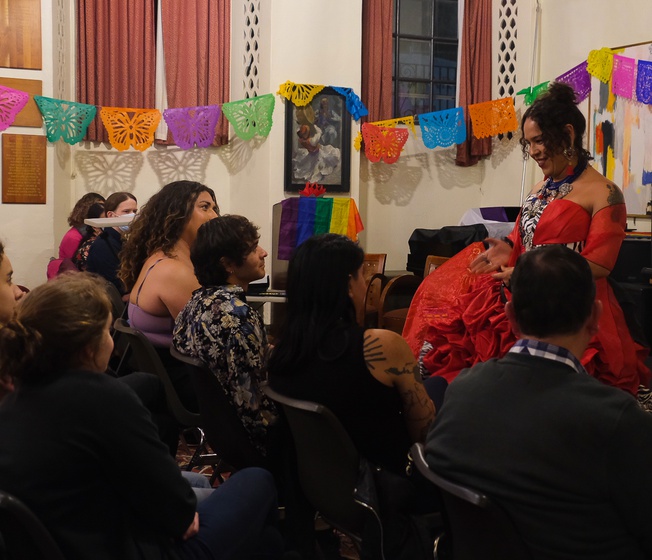{shortcode-c9ed43292ac3c81b11ada9abf4e3b8ce90ac4639}
This April 1, a breezy Saturday night, a lively crowd dances to “No Rompas Mi Corazón” in Adams House dining hall, the aroma of frijoles refritos and arroz rojo wafting through the air. You wouldn’t know from their energy on the dance floor that minutes earlier, they had been sitting quietly, attentively watching a documentary about trans lives, vulnerability, and the meaning of freedom.
A party that educates as much as it celebrates, TransQuinceañera, an event hosted by the Graduate School of Arts and Sciences Latinx Student Association and the LGBTQ@GSAS Association, has invited the Harvard community to a vibrant evening of art and activism.
“I create another narrative of the ritual. That night, I become the TransQuinceañera,” says the star of the show, Lía García, also known by her stage name La Novia Sirena. “For me, it’s important to create these safe spaces to celebrate our transitions and to talk in first person.”
García is an artist, activist, and educator who performs at quinceañeras at educational institutions, prisons, train stations, and other public spaces to spread awareness of trans issues. She collaborated with the GSAS associations to put on this event in honor of Trans Day of Visibility and Women’s History Month, as well as to celebrate the intersectionality of gender and heritage.
The night starts off with a showing of “Mis XXy Años,” a documentary by Ebony Bailey showcasing La Novia Sirena’s performance art (La Novia Sirena translates to “the mermaid bride”). The documentary is narrated by García, entirely in Spanish, expressing her childhood fantasies of embodying femininity, and features scenes of her in her hometown, Mexico City, spinning in bejeweled pink taffeta in a plaza and dancing with a blue parasol in a subway station. In the documentary, crowds are drawn to her elaborate dresses, and linger to hear her message.
After the screening ends, García herself emerges in a red and zebra print quinceañera dress, her face lit up with a warm smile as she floats around the room of intent listeners.
{shortcode-4fe3126ddf174cbcfca663ff6211dee43e55d1d8}
“Think about how many cages we have in our own body,” she asks her audience, as she passes around a cage, inviting individuals to hold it and release what makes them feel trapped as a lesson of the importance of freedom. She asks the audience, “When was the last time a professor asked you how you’re doing?”
“I really loved her message about thinking about the possibility of reshaping the university and academic spaces as spaces of care and tenderness,” says Massiel Torres Ulloa, a Ph.D. candidate in Romance Languages and Literature.
Momentarily, García’s presentation is interrupted by sudden rapping on the rightmost window. The audience’s gaze is disturbed by a man standing outside, only illuminated by the light from inside the room, giving the finger. There are murmured groans of disdain and a beat of confusion. But García stands boldly, still smiling, dismissing the act of hate and continues conversing with her audience. Michael Ángel R. Vázquez, a Ph.D. candidate in Education and organizer of the event, smoothly shuts the curtain and steps outside Adams to address the stranger on the sidewalk.
A resident of Mexico, García intends her performance to be a political response as well as a social celebration. “I think the quinceañera has very patriarchal roots,” she says. “This emotional encounter of the TransQuinceañera is another kind of aesthetic, a political aesthetic, a response to the spectacle of violence.”
Performance art, for García, is a way to directly address the confining gender roles of machismo from her childhood, and a way to desexualize expressions of intimacy, like touch. “The performance is something for healing,” she says. “This is the power of art and the power of trans pedagogy that help us to heal the colonization that is in our bodies.”
As an LGBTQ+ person of Latin American heritage himself, Vázquez wants to emphasize the importance of intersectionality in allowing him to embrace his identity. “I also want to dispel the myth that communities of color are inherently more transphobic or homophobic. And that’s simply not true,” he says. “Our cultures are also rooted in love.”
García expresses her gratitude for Harvard’s welcome of her and the event, because she believes Harvard would benefit from a stronger LGBTQ+ community, from students to professors to faculty and staff. Though, Vázquez clarifies, “It was Jarvar that invited Lía.” Jarvar is an informal yet thriving community on campus established by the Latinx Student Association, affectionately named after a pronunciation of Harvard “the way many of our parents say it.”
Vázquez says TransQuinceañera is a “reclamation” of the harm that Harvard has caused to LGBTQ+ people, referencing the Secret Court of 1920, when LGBTQ+ identifying students were “actively hunted” and expelled by Harvard’s administration. “There’s this moral imperative that we feel by bringing it not just to academia, but to Harvard specifically, because of Harvard’s harm in promoting transphobia,” he says.
In a 2002 statement to The Crimson, former Harvard President Lawrence H. Summers wrote that he expresses “deep regret” for the University’s past expulsion of LGBTQ+ identifying students.
“Whatever attitudes may have been prevalent then, persecuting individuals on the basis of sexual orientation is abhorrent and an affront to the values of our university,” he wrote. “We are a better and more just community today because those attitudes have changed as much as they have.”
Vázquez says TransQuinceañera serves as a both a source of entertainment and education.
“This is another way of pedagogy, of teaching, that’s so effective and so beautiful,” Vázquez says.


